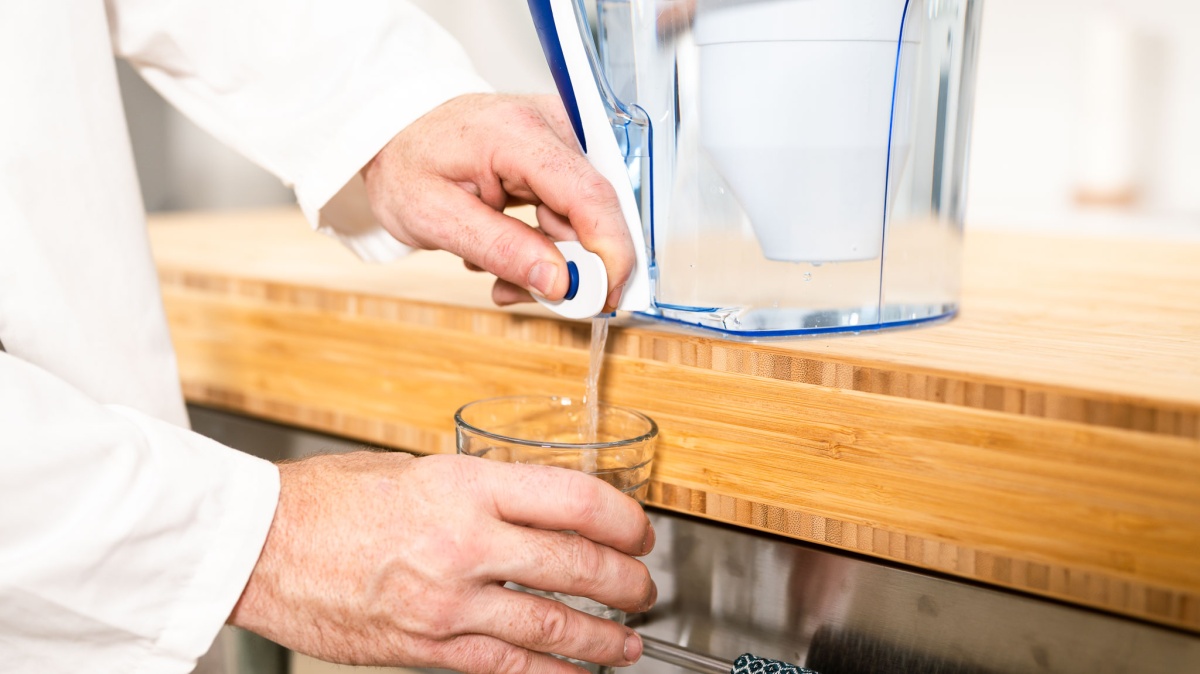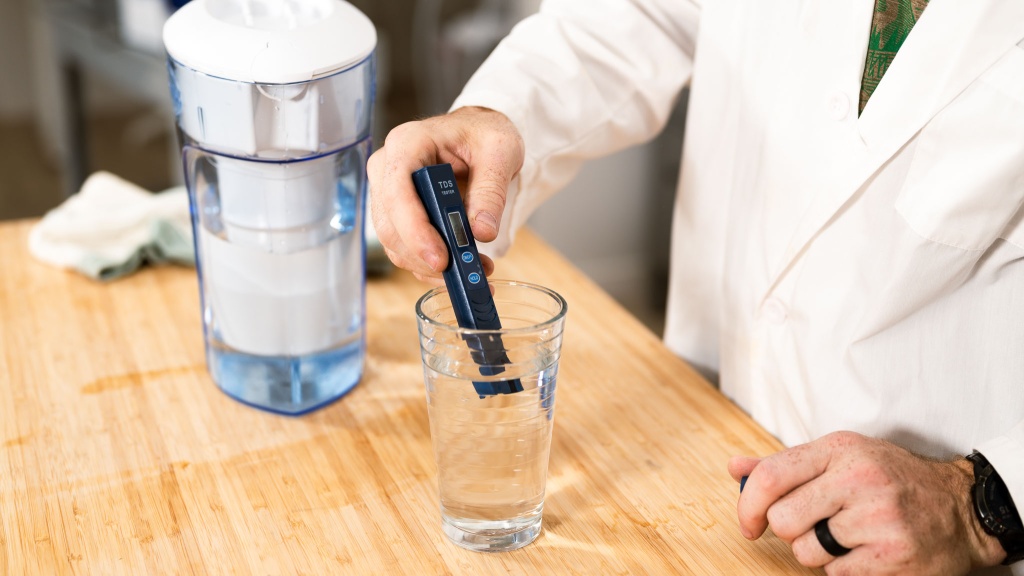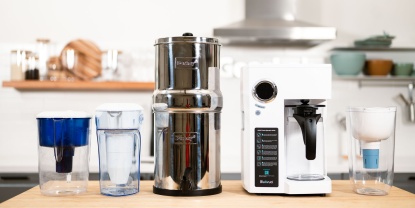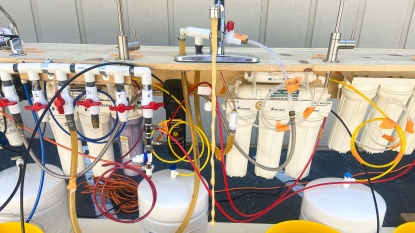Our Verdict
Compare to Similar Products
 This Product
ZeroWater 10-Cup 5-Stage Pitcher | |||||
|---|---|---|---|---|---|
| Awards | |||||
| Price | $35 List $34.99 at Amazon | $220 List $168.29 at Amazon | $30 List $24.99 at Amazon | $145 List $139.95 at Amazon | $42 List $44.99 at Amazon |
Overall Score  |
|||||
| Star Rating | |||||
| Bottom Line | Top-notch filtration and convenience at an affordable price point | If you have space and are willing to install a one-time system, this is the best way to purify your water | A low-cost pitcher that easily produces high-quality water | Reduced installation hassle, comparable filtering power, and lowest yearly cost | An easy-to-use water pitcher that produces good-tasting water, but struggles to remove certain contaminants |
| Rating Categories | ZeroWater 10-Cup 5-... | iSpring RCC7 | PUR Classic 11 Cup... | APEC WFS-1000 | Brita Tahoe 10-Cup... |
| Contaminant Removal (60%) | |||||
| Taste (30%) | |||||
| Setup and Use (10%) | |||||
| Specs | ZeroWater 10-Cup 5-... | iSpring RCC7 | PUR Classic 11 Cup... | APEC WFS-1000 | Brita Tahoe 10-Cup... |
| Type | Pitcher | Reverse Osmosis | Pitcher | 3 Stage under sink | Pitcher |
| Measured Annual Cost | $57.50 | $50.00 | $36.00 | $40.00 | $30.49 |
| Measured Chlorine Removal | 100% | 100% | 95% | 100% | 75% |
| Measured Fluoride Removal | 100% | 100% | 100% | 100% | 37% |
| Measured Sulfate Removal | 100% | 100% | 35% | 39% | 43% |
| Measured Copper Removal | 100% | 100% | 88% | 100% | 17% |
| Measured Iron Removal | 99% | 100% | 85% | 46% | 35% |
| Measured Lead Removal | 100% | 100% | 100% | 100% | 100% |
| Model | 10 Cup | RCC7 | 11 Cup | WFS-1000 | 10 Cup |
| Replacement Schedule | 18,000 mg of dissolved solids; 1-40 gallons | Stage 1 - 3 every 6 months RO every 2 - 3 years Post carbon every 12 months |
2 months or 40 gallons | Every 12 months | Every 120 gallons, or about every 6 months |
| Replacement Cost | 2 for $30 4 for $40 8 for $90 12 for $115 16 for $150 |
2 year supply for $100 | $24 for a 4 pack | Stages 1-3 for $40 | $18.40 per filter, $30.49 for two |
| Pure Water to Waste Water Ratio | N/A | 2:1 | N/A | N/A | N/A |
| NSF/ANSI certified | 5-stage Ion Exchange water filtration is NSF Certified to reduce PFOA/PFOS, Lead & Chromium | N/A | Tested and certified by NSF to reduce chlorine, mercury, copper, zinc and other chemical & physical substances. | NSF Certified filters and tubing | Systems tested and certified by the WQA against NSF/ANSI Standards 42 and 53 for the reduction of the claims specified on the Performance Data Sheet. |
| Follows NSF/ANSI or other cert | N/A | In strict accordance with American quality standards. Certified to NSF/ANSI 58 | N/A | N/A | N/A |
Our Analysis and Test Results
The ZeroWater 10 Cup 5 Stage Filter is the gold standard for water filtration, whether a pitcher or not. The 5-stage filter was among the best for contaminant removal, and its easy-to-use nature was on par with other pitchers. A Kilner Jug-style spigot on the pitcher's handle allows convenient access to water while it's in the fridge or still filtering from the upper compartment. The ZeroWater is a favorite amongst our test team for its effective filtration, delicious water, and convenience.
Performance Comparison
Contaminant Removal
Water filters have become more popular and essential as some municipal water sources become comprised and consumers become more aware of what we put in our bodies. We often have no idea what invisible contaminants are within our tap water unless it comes out an off-color. Water filters help provide peace of mind that the water you drink supports a healthy lifestyle. To identify the most efficient water filters, we produced a water sample containing elevated concentrations of chlorine, iron, sulfate, lead, fluoride, and copper. An independent lab, Western Environmental Testing Laboratories, analyzed the resulting purified water samples. The ZeroWater was one of the most effective filters at eliminating undesired impurities within the review.
The model uses filters certified by the NSF to remove chromium, Polyfluorinated alkyl substances (PFOA/PFOS), and lead. Not every filter is suited or certified to pull out PFOA/PFOS. This is a chemical commonly used for common items such as nonstick cookware, stain-resistant clothing, and firefighting foams and can leech into water sources. A 2023 United States Geological Survey (USGS) study estimates that 45% of tap water contains PFOA/PFOS. According to the EPA, these chemicals can bioaccumulate with humans and pets within the blood, kidneys, and liver. Exposure can cause developmental, reproductive, and systemic problems. We didn't test the filter's effectiveness on these chemicals, but few filters hold this certification. The NSF certification verifies its removal of these chemicals.
In our testing, this pitcher removed 100% of the chlorine (12mg/l out of 12mg/l), 100% fluoride (10mg/l out of 10mg/l), 100% sulfate (2300mg/l out of 2300 mg/l), 100% copper (52mg/l out of 52 mg/l), 99.46% iron (626.6mg/l out of 630 mg/l), and 100% lead (.02 mg/l out of .02 mg/l). The ZeroWater is the only pitcher that filters out nearly all contaminants. This model only left an impressive 3.4mg/l of contaminants in its purified sample. In our initial test sample, each contaminant was far above the acceptable standard, which helped simulate a compromised water system. The ZeroWater filter is one of the best-performing filters on the market and is suitable for nearly any water source.
Taste
Water filters can improve the taste of tap water, especially if it has an off-putting metallic or chemical taste. Poor-tasting water makes drinking water a chore and could come with an added cost for bottled water. However, taste is subjective, and some people prefer a mineral taste, while others prefer a neutral taste. Water filters face a challenging task for those who prefer mineral water as they remove as many impurities as possible, including some of those flavor-enhancing minerals. To help describe and rank taste, our test team performed a blind taste test with each filter using the finest garden hose water to produce a glass. The ZeroWater was loved or passed over by our test team due to a flat, light, and nearly distilled flavor profile.
The impressive filtration power of this filter can remove the majority of dissolved solids, giving it a very light taste, which may be great for some but leave those who like more mineralized water wanting more. The water that came from this filter is around two ppm. While that degree of filtration is impressive, the water carries that distilled and light character. For reference, distilled water is around 0.5 ppm, while the popular bottled water brand Figi is 210 ppm. The amount and character of a water's TDS are largely responsible for its great or even horrible taste.
The ZeroWater has reviews on both ends of the spectrum. Some testers ranked it as poor, while others ranked it as excellent. This highlights the subjective nature of taste. This filter should easily rid your tap water of chlorine or metallic flavors and substantially improve overall taste. It comes down to understanding what taste and experience you are after. This filter ultimately produces water with a clean, light, and neutral presence.
Setup and Use
We don't always think about our utilities; we hit a switch, and the lights come on or turn the faucet, and water streams out. A water filter should preserve that background role. Water pitchers vary in user experience, particularly in setup and ongoing use. Water pitchers are not all created equal. The installation, daily usage, long-term maintenance, and overall cost can vary and help inform your decision. Our test team installs and then assesses the setup process and daily usage. We also consider the annual cost of the filter and maintenance schedule. The ZeroWater has virtually no setup and is easy to maintain but comes with a slightly higher annual cost than other pitchers in the review.
The setup is simple: wash the pitcher with soap and warm water or in the dishwasher, then rinse the filter for 30 seconds. After that, you can screw the threaded filter into the receiver. Voila, you are ready to fill the pitcher up and start filtering. The entire process is less than 10 minutes — fast and simple.
The ZeroWater provides an easy-to-use experience, as do most other pitchers. Most notably, it has a gravity-fed spigot on the handle side of the pitcher to allow access to water while the upper zone is filtering. The Spigot allows you to take the pitcher out of the fridge and position it near the edge of a shelf to access water like a Kilner jar.
The maintenance is as easy as the setup: wash the pitcher and replace the filter. The filters are more expensive than other pitchers due to the 5 stage construction responsible for best-in-class filtration. The filter should be replaced when the included TDS meter reads six ppm; the expected life of a filter is around 18,000 mg of dissolved solids, generally around 40 gallons. The cost and life span of the filters give the model the highest annual cost among pitchers at $57.50.
Should You Buy the ZeroWater 10 Cup 5 Stage ?
The ZeroWater 10 Cup 5 Stage is one of the best filters on the market. It is an impressive product due to its filtration performance and functional design, like the fixture on the backside. We recommend this product for those looking for top-tier filtration to enhance your drinking water.
What Other Water Filters Should You Consider?
If you're looking for a pitcher that delivers the best-tasting water, consider the PUR Classic 11 Cup Pitcher. It emerged as one of the top choices in our blind taste tests. If you're looking for a top-tier reverse osmosis filter that sits on your countertop, we recommend the Bluevua RO100ROPOT.













